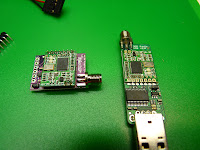The much-anticipated 3DR radio arrived yesterday, in the stylish new 3DR black box. Hooray! After having so much xbee grief, I had high hopes that this would solve all my telemetry-related problems.
TLDR: it's great!
As advertised, the kit comes with a ground radio, an air radio, two antennas, cables for each, and a header for the air radio. As a nice bonus, they included enough 1-1/4'' shrink tube to cover both radios. Nice!
Here's what the radio units look like. The ground unit plugs directly into a USB. Both Mac and Windows 7 recognized it and downloaded the proper driver. The included ground cable is a standard USB extension cable. (Use the cable, and don't plug the ground unit directly into a USB port. There's no other attachment to the board other than the soldered connections, so the USB connector will break off if there's any stress applied while in the computer's USB port. Thanks to Andreas Antonopoulos for this tip!)
As you can see here, the air unit doesn't have the headers soldered on.
The approximate weight of the air unit is 17.4 grams, not counting solder or shrink tube. It's possible to replace the antenna with a lighter quarter-wave wire antenna. Tridge mentioned that he did some of his initial testing with such a setup.
Stick a label onto your antenna before you get it mixed up with a 2.4GHz or other sized antenna. They look pretty similar but won't work.
Here's how to attach the air unit cable. Use the end of the cable that has the 5-pin plug.The RTS pin is left bare, and the wire gap is closest to GND. If you've got the red wire on 5V you're good -- there's only one orientation where that works.
Here's the air unit shrink wrapped and with cable attached.
Here's the radio pins on the APM2. It's located at the rear of the board. There are four pins, and you use the end of the cable that has the four-pin connector.
Looking forward (as in this picture), the red power wire is towards the left.
Once the air unit is hooked up, power on the APM, attach the ground unit to your computer (via USB), run the APM planner, and press control-A. Be sure to be in disconnected mode. You will get the 3DR radio configuration screen. Press "Load Settings" and you should get the settings for both the ground and air radios. Exit this screen, and you should be able to connect as normal. The configuration was read immediately (no "timeout in ..." messages!!) It took about 5 seconds from connect time for the APM Planner to start responding.
Once you've verified it's working, you will want to change the network ID if you're planning on flying near anybody else using a 3DR radio.
Summary: overall I'm very happy. I spend about an hour setting things up (including taking pics and notes), and it's working smoothly.
Viewing Radio Stats
Michael Oborne points out: 'in the planner under "Status" and "tuning" you can see all the values tridge included in his graph live.'
What to do if your network binding goes awry
Of course, this would not be a certified Mark Harrison Radio Experience (tm) if at least one thing did not go wrong. In this case, changing the network ID failed on the air radio, so I was stuck with a ground radio with an ID of 26 and an air ID of 25. Fortunately this was not too difficult to clear up; I'll cover that in the next post. (update: here.)










